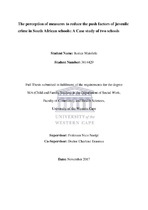| dc.description.abstract | The African Charter on the Rights and Welfare of the Child (2000) emphasizes that
all actions which pertains to children should be in their best interest and this includes the
welfare of learners in schools. This study sought to explore the perception of measures to
reduce the push factors of juvenile crime in two South African schools. A Social Learning
Theory was employed as the theoretical lens for this study and a qualitative case study
approach, which is explorative and descriptive in nature, was also used. An interview
schedule was used to collect data focusing on in-depth interviews and focus group
discussions with participants as well as key informants. Convenience sampling, which is a
non- probability type of sampling that entails the selection of samples based on their
convenience and accessibility was used given the sensitive aspect of this particular study,
especially on the identification of research participants. A sample of seven focus groups
consisting of seven participants was drawn from the entire population of two selected schools
in order to have a minimum of 49 representatives from each school. Audio recordings and
transcribed verbatim were analyzed by the researcher as data collection technique. A thematic
analysis, which looks across all data to identify common issues and recurring themes, was
used. This research sought to be ethically considerate, adhering to codes such as
confidentiality, informed consent, voluntary participation and others. Findings indicate that
five crimes (substance use, stealing, bullying, physical fights and gangster activity) identified
as recurring themes during the general preliminary investigation of juvenile crimes were also
identified as common crimes at the two selected schools. Another observation in this study
was that school juvenile offenders are generally cognisant of push factors of juvenile crime in
schools, but are less informed when it comes to assimilating push factors with measures to
reduce juvenile crimes. | |

